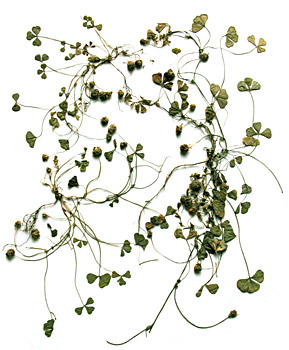Relatives
Trifolium subterraneum L.- Subterranean clover, subclover.
Taxonomic position.
Family Leguminosae Endl., genus Trifolium L., sect. Trichocephalum Koch.Biology and morphology.
Annual herb. Tap root with many lateral branches. Stems are branched, prostrate, pubescent, up to 0.5 m. Leaves are trifoliate, leaflets 0.8-2.0 cm long, triangular to obcordate, finely toothed, hairy on both sides. Stipules are small and pointed, varying in hairiness and color of stripes, which range from pale green to red. Inflorescences, arising from leaf axils, contain 3-6 florets, l-l.5 cm; corolla white, creamy white or pinkish. Calyx pigmentation can be green or have a red band covering 25% to 75% of the tube. After self-fertilization, peduncles bend over and florets deflex, becoming brown. Several sterile, spiny florets emerge at the end of the peduncle, enclosing 2-4 ripening seeds in the dried-out corolla and calyx. These seed burrs become embedded or buried in the upper layer of the soil during summer for subsequent germination in autumn. Pod is one-seeded. Seeds oval, with pronounced hilum. Strongly self-fertile; 2n = l6.Distribution.
South of Crimea, seashores in Caucasus, Dagestan and Azerbaijan; Cura lowland.Ecology.
In forests and meadows, along riversides up to mid-mountain level (800 m). Adapted to regions with hot dry summers, moist, mild winters; also to warm, temperate areas. Prefers sandy soils.Utilization and economic value.
Adapted to a range of dry climatic and edaphic conditions. Highly tolerant to grazing and highly nutritious. High degree of resistance to diseases and pests. Nitrogen-fixation ability makes subclover a valuable pivotal crop in pasture-arable crop rotations. The soil seed bank maintains large reserves of seed available for seasons of low seed production. Can flower and set seed under intensive grazing.Reference citations:
Brezhnev D.D., Korovina O.N. 1980. Wild relatives of the cultivated plants of flora of the USSR. Leningrad: Kolos. 376 pp. (In Russian)Galushko, A.I. 1980. Flora of Northern Caucasus: A field guide. Rostov-na-Donu. V. 2: 350. (In Russian)
Grossheim, A.A. 1952. Genus Trifolium. Flora of the Caucasus. Moscow-Leningrad: AN USSR. V.5: 191-221. (In Russian)
Kolakovskiy, A.L. 1958. Flora of Abhasiya. Tbilisi. V. 3: 292. (In Russian)
Mukhina, N.A. & A.K. Stankevich, ed. 1993. Flora of cultivated plants. Trifolium, Lotus. Moscow: Kolos. V. 13: 334 pp. (In Russian)
Phyodorov, A.A., ed. 1987. Flora of the European part of the USSR. V. 6: 254. (In Russian)
Schischkin, V.K. & E.G. Bobrov, ed. 1945. Flora of the USSR. Moscow-Leningrad: AN USSR. V. 11: 129 176. (In Russian)


